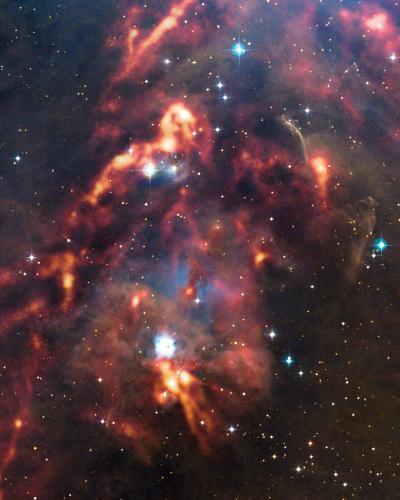A new image from the Atacama Pathfinder Experiment (APEX) telescope in Chile shows a beautiful view of clouds of cosmic dust
nebula NGC 1999
in the region of Orion. While these dense interstellar clouds seem dark and obscured to visible-light observations, APEX’s LABOCA camera can detect the heat glow of the dust and reveal the hiding places where new stars are being formed. But one of these dark clouds is not what it seems.
In space, dense clouds of cosmic gas and dust are the birthplaces of new stars. In visible light, this dust is dark and obscuring, hiding the stars behind it. So much so that, when astronomer William Herschel observed one such cloud in the constellation of Scorpius in 1774, he thought it was a region empty of stars and is said to have exclaimed, "Hier ist wahrhaftig ein Loch im Himmel!"(Truly there is a hole in the heavens here!)
Telescopes that can observe at longer wavelengths, like the submillimetre range in which the dark dust grains shine rather than absorb light, are ideal for astronomers studying the birth of stars. Located in the constellation of Orion (The Hunter), 1500 light-years away from Earth, the Orion Molecular Cloud Complex is the closest region of massive star formation to Earth, and contains a treasury of bright nebulae, dark clouds and young stars.
The new image shows just part of this vast complex in visible light, with the APEX observations overlaid in brilliant orange tones that seem to set the dark clouds on fire. Often, the glowing knots from APEX correspond to darker patches in visible light -- the tell-tale sign of a dense cloud of dust that absorbs visible light, but glows at submillimetre wavelengths, and possibly a site of star formation.

While these dense interstellar clouds seem dark and obscured in visible-light observations, APEX's LABOCA camera can detect the heat glow of the dust and reveal the hiding places where new stars are being formed. The image shows the region around the reflection nebula NGC 1999 in visible light, with the APEX observations overlaid in brilliant orange tones that seem to set the dark clouds on fire. Credit: ESO/APEX (MPIfR/ESO/OSO)/T. Stanke et al./Digitized Sky Survey 2
The bright patch below of the centre of the image is the nebula NGC 1999. This region, when seen in visible light, is what astronomers call a reflection nebula, where the pale blue glow of background starlight is reflected from clouds of dust. The nebula is mainly illuminated by the energetic radiation from the young star V380 Orionis lurking at its heart. V380 Orionis has a high surface temperature of about 10 000 Kelvin, nearly twice that of our own Sun, and its mass is estimated at 3.5 times that of the Sun.
In the center of the nebula is a dark patch, which can be seen even more clearly in a well-known image from the NASA/ESA Hubble Space Telescope.
Normally, a dark patch such as this would indicate a dense cloud of cosmic dust, obscuring the stars and nebula behind it. However, in this image we can see that the patch remains strikingly dark, even when the APEX observations are included. Thanks to these APEX observations, combined with infrared observations from other telescopes, astronomers believe that the patch is in fact a hole or cavity in the nebula, excavated by material flowing out of the star V380 Orionis. For once, it truly is a hole in the sky!
The region in this image is located about two degrees south of the large and well-known Orion Nebula (Messier 42), which can be seen at the top edge of the wider view in visible light from the Digitized Sky Survey.




Comments